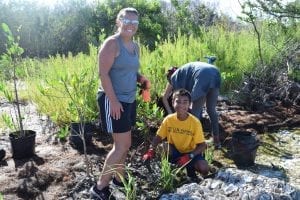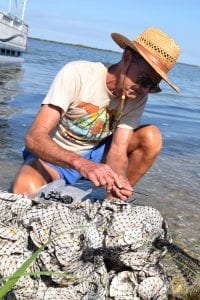Stabilizing the Shoreline an Oyster at a Time

Linda Walters, Ph.D., and Melinda Donnelly, Ph.D. work together to stabilize Florida’s estuarine shorelines that have severely eroded due to storms and boat wakes. Since 2007 the duo’s work has restored 82 reefs and stabilized over 2000 meters of shoreline. Without volunteers and grants from various organizations, their work wouldn’t be possible.
In early July, Walters and Donnelly ran shoreline stabilization for four straight days. Over 150 volunteers made up of UCF faculty, administrators, staff and students as well as National Park staff, partners from the Coastal Conservation Association and the New Smyrna Beach Marine Discovery Center, went to Canaveral National Seashore to help. Not only is the stabilization necessary for the environment, it has historic implications as well.
“The erosion is especially dangerous for the areas we stabilize as all have historic importance,” Walters said. “They are either historic structures or are Native American shell middens that date back to the year 700.”
 As for the environmental impact, the teams also plant marsh grass and mangrove trees to trap sediment. This helps keeps the shorelines from eroding.
As for the environmental impact, the teams also plant marsh grass and mangrove trees to trap sediment. This helps keeps the shorelines from eroding.
Another unique aspect are the 40-plus-pound oyster shell bags. “We deploy the oyster shell bags seaward of the plants,” Walters said. “These shells accumulate new oysters and help create fringing reefs.”
Over the past six years, Walters has mobilized over 10,000 volunteers to continue her work with Donnelly on living shorelines and nearly 50,000 volunteers for oyster reef restoration. Her project was one of the first in the state of Florida to begin stabilizing shorelines, and the first on the East coast of central Florida. Volusia County even honored her with her own day, November 6, – Dr. Linda Walters’ Day – back in 2011.
Walters’ sees volunteers return numerous times and many students even begin their conservation careers at these projects. She also notes community members become more aware of their environment and many go on to lead their own initiatives to protect our coasts.
“We need to protect these shorelines to protect our history into the future,” she said.
There are many projects underway in Florida. If you’d like to volunteer, Walters has another Living Shoreline Stabilization project at De Soto National Park in Bradenton, Florida, on August 12 and 13.
“Wear old sneakers and old clothes, as they will get a bit wet,” Walters said. “Bring a water bottle, snacks and good attitude. The work is intense, but satisfying and moderately strenuous.”
Learn more about the Living Shoreline Stabilization project.
